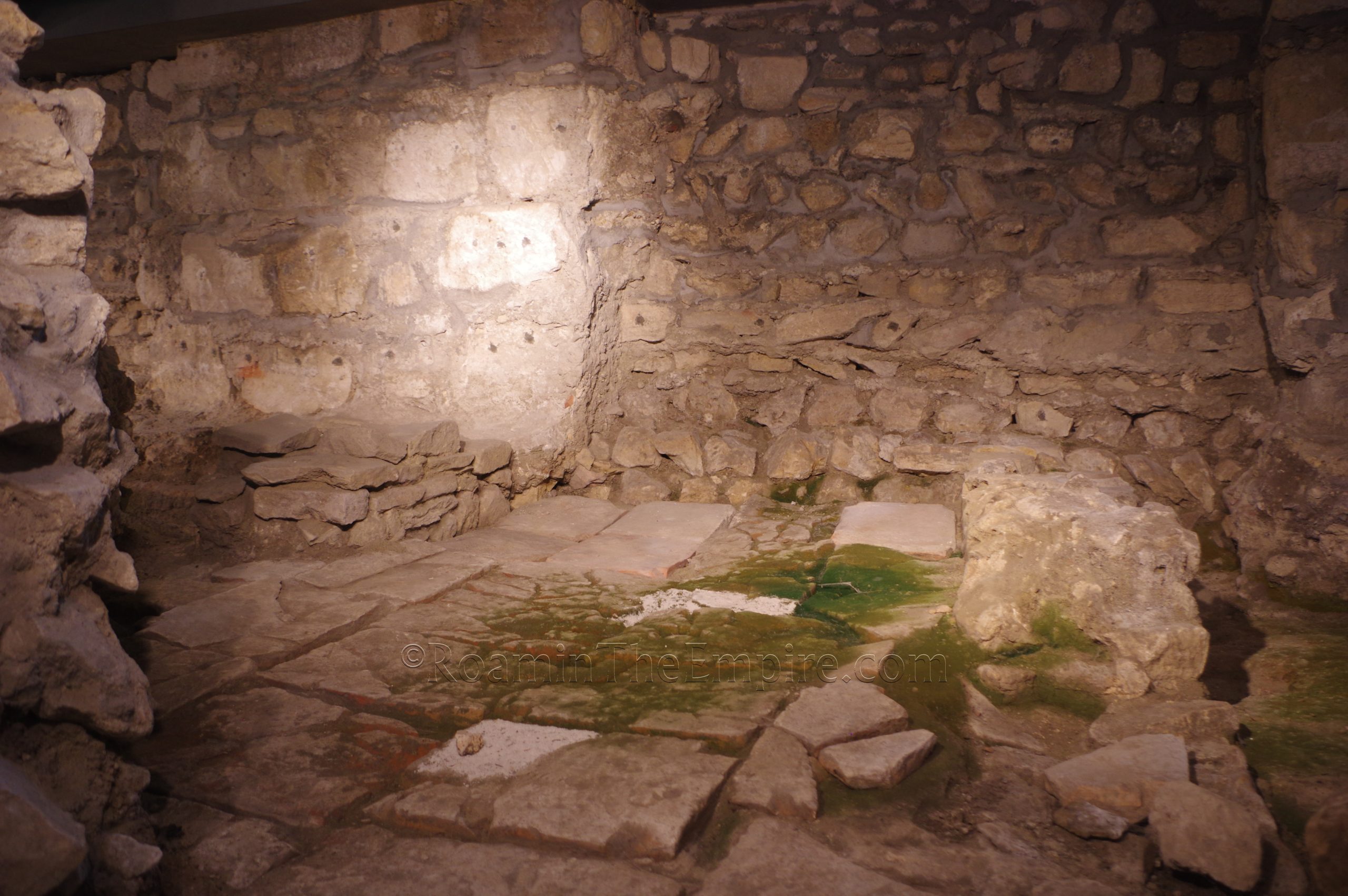
Continued From Aquincum, Pannonia Inferior – Part V
With the civilian and military settlements of Aquincum wrapped up, there are a few more interesting things to see closer to central Budapest, nearly 5 kilometers south of the military amphitheater. In antiquity, the site of the Erzsébet híd, the Erzsébet Bridge connecting the central parts of Buda and Pest, was the site of a bridge crossing over the Danubius. On the eastern bank of the river was the fort of Contra-Aquincum, constructed in the late 2nd century CE. There are a few remains of this small fort in the area.
The first bit of the fort can be found at the Budapest-Belvárosi Nagyboldogasszony Főplébánia-templom, the Budapest Inner-City Mother Church of Our Lady of the Assumption. The church is open Monday to Wednesday from 9:00 to 18:00 and Thursday to Sunday from 8:30 to 19:00. Sunday visits, of course, have to take into account church services. The church is technically free to enter, though it was kind of implied the lady at the door that I could only go in for worship purposes, rather than buy a ticket for the tourist route. More on that shortly. A couple walls and some supposed elements from the floor heating of the fort commander’s quarters are visible through glass on the left (east) side of the nave. When I first went in (admittedly close to opening time), none of this was illuminated, but eventually a light was turned on and it was pretty easy to see. These remains date to the 2nd-3rd century CE.
It is possible to go into the crypt to see these as well. A ticket can be purchased for 2600 Forint to visit the crypt as well as the bell tower. Honestly, the ticket really isn’t worth it. You can basically see the same thing you can see from the nave, and one additional, indistinct Roman wall dating to the 3rd century CE. That’s pretty much it unless you are interested in the later early church. In fact, it was actually frustrating because there are some pictures down there of the excavations that show a lot more of the Roman remains that were found, and seemingly cleared in favor of the later church structures. The bell tower visit also isn’t anything to write home about. Considering the admission price is 400 Forint more than the admission price to the Archaeological Park of Aquincum, it seems like an extortionate amount. I would wholeheartedly recommend just seeing what you can see from the nave and not wasting the time and money on the crypt and bell tower ticket.
Just in front of the church is a park and a large pedestrian way between the park and church, Március 15. tér. Embedded in the stones of this pedestrian walkway is a schematic representation of the Danubian Limes. The river itself is etched into the stone, and major forts and settlements are represented by bronze plaques placed at, what I would assume, are relative distances to one another. This continues to the north before wrapping to the west before hitting the street bounding the northern side of the square. Within this bend is a low concrete structure with a couple of windows on the north side. Housed in the structure are some of the fortification walls and what appears to be a tower. There’s no direct access, it’s only visible through the windows. It’s hard to see in the daytime, because the interior lighting is provided by a couple of small light wells on top of the structure, and the glare on the windows makes it hard to see. At night, however, the interior is lit up, and without the glare, it’s much easier to see.
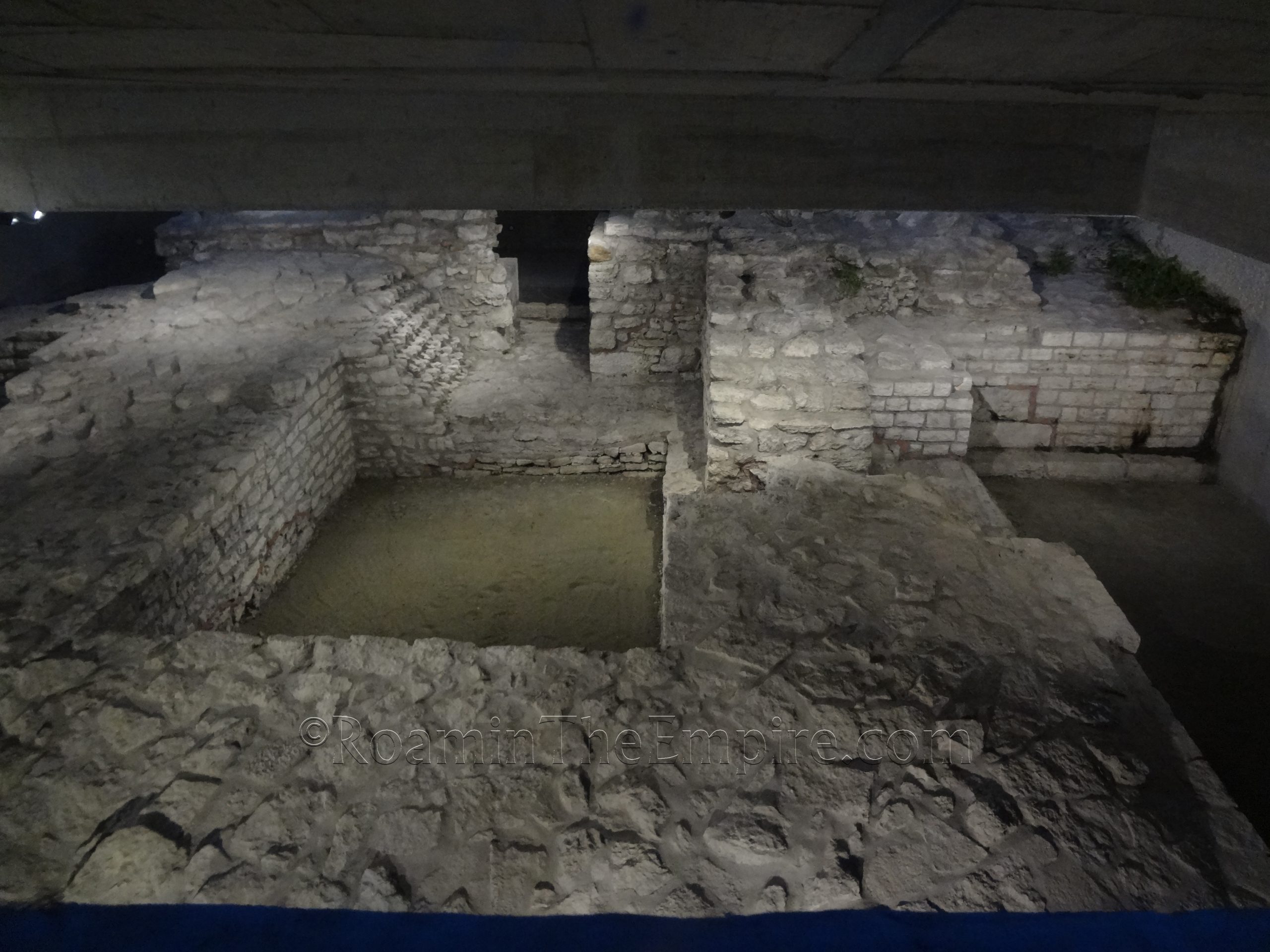
Though that wraps up the archaeological remains of Aquincum and the vicinity of Budapest dating to the Roman period, there are also two excellent museums with large collections of Roman antiquities in Budapest. Closest to the center (and the remains of Contra-Aquincum, which I visited the same day) is the Magyar Nemzeti Múzeum, the Hungarian National Museum. It is located about 1.2 kilometers and 15 minutes walking from Contra-Aquincum at Múzeum krt. 14-16. It is open between Tuesday and Sunday from 10:00 to 18:00 and is closed on Mondays. Standard admission is 3,500 Forint, but there is also a 900 Forint surcharge for taking photos; this includes cell phone pictures as well as camera pictures. The museum staff seemed to be pretty on top of getting after people who didn’t have the sticker indicating they had paid the photo surcharge as well.
The Hungarian National Museum has, first and foremost, and absolutely fantastic lapidary collection in the basement. The upper part of the lapidarium contains a mix of funerary inscriptions (many relating to soldiers and veterans) as well as building inscriptions, imperial dedications, and religious altars. The right side (relative to the entrance) also contains some display cases with a number smaller objects, including bronzes, related to religious functions. Among these are a double-sided bronze relief dedicated to Jupiter Dolichenus and a bronze Mithraic tauroctony relief. The lower level of the lapidarium has a large floor mosaic from a Roman villa and a collection of sarcophagi and funerary reliefs. Many of the funerary reliefs depict an array of mythological scenes.
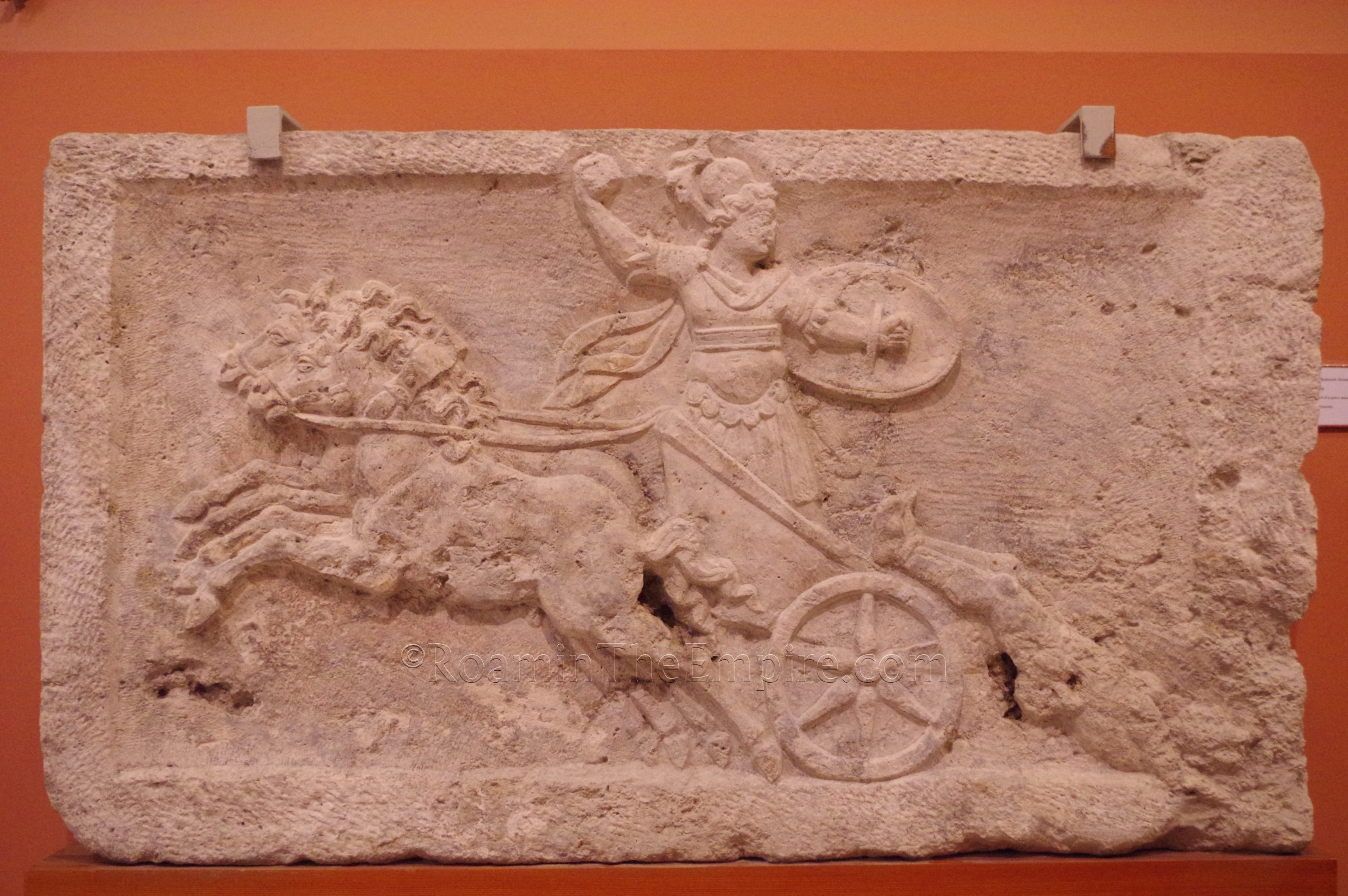
On the ground floor, the museum also has a separate archaeological collection that spans through the history of habitation in Hungary from around 400,000 BCE until the 9th century CE. One of the larger rooms is dedicated to finds from the Roman period, which include a number of smaller bronzes and many bronze elements from a chariot. Some of the highlights also include several bronze parade helmets, a bronze statuette of Victory, and terracotta models of a lighthouse and city gate. One thing of note is that the lighting in these rooms is absolutely atrocious and made for a pretty frustrating time attempting photographs. Normally I wouldn’t be so indignant about that, but, if you’re going to make me pay to take photographs, I think it’s a bit disingenuous to then effectively prevent people from doing so by using horrible lighting through a big chunk of the museum. The bronze and iron age rooms are also interesting for tracing the evolution of local artistic themes that would continue through after the arrival of Roman hegemony.
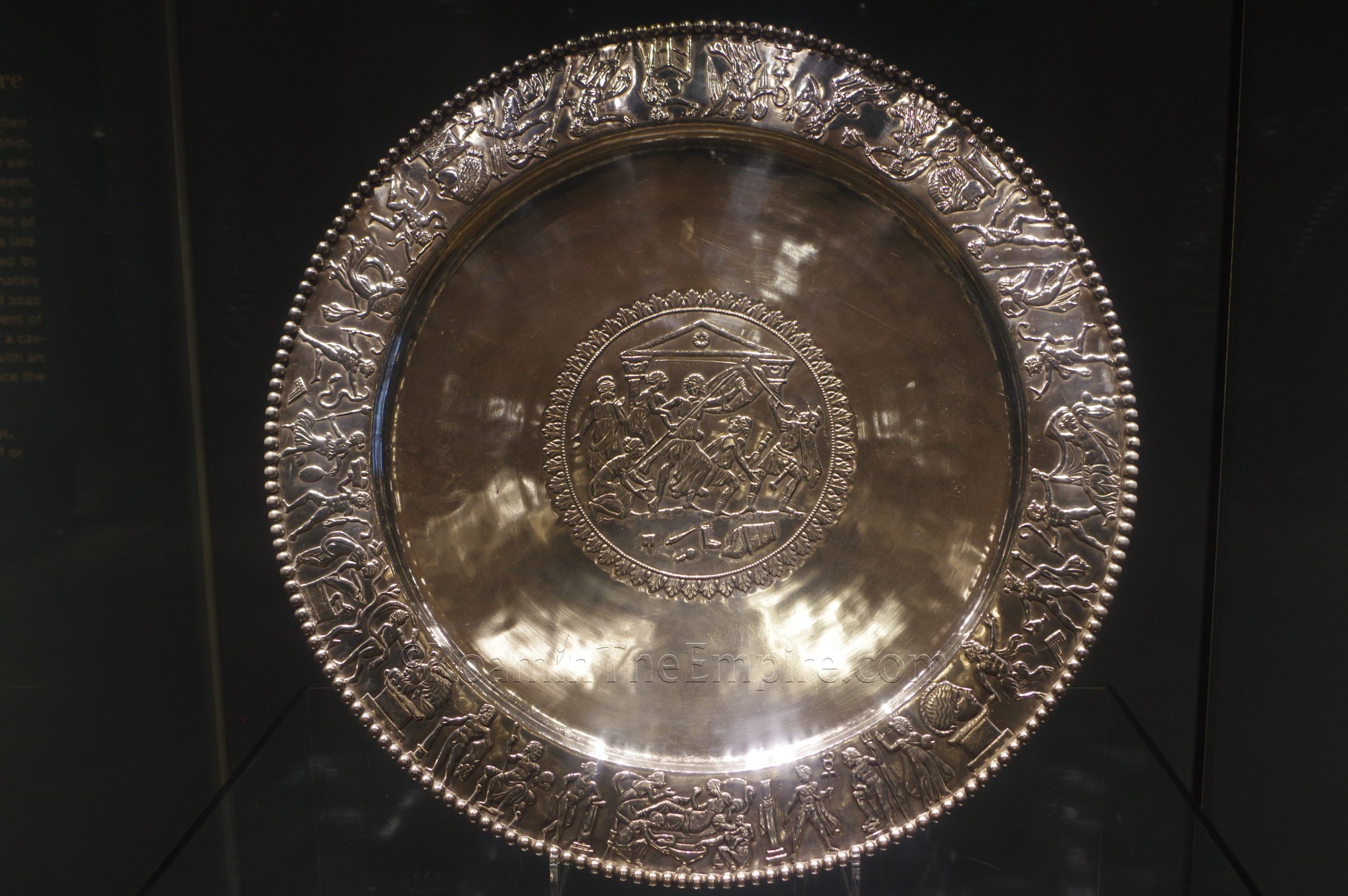
Perhaps the biggest highlight of the museum is the Sueso Treasure, a horde of 14 well-preserved silver vessels dating to the late 4th or early 5th century CE. The name derives from an inscription found on the bronze cauldron in which the silver vessels were found, which mentions the name Sueso. Many of the pieces have ornate incised or relief design featuring animals and figures. One platter, the largest of the treasure, depicts Achilles on Skyros at the center, with scenes of his Achilles birth, the contest between Athena and Poseidon for Athens, the discovery of Ariadne, and other Dionysiac scenes along the rim. Another features Meleager and the Calydonian boar hunt at center with various mythological scenes including Pyramus and Thisbe, the Judgement of Paris, Persueus and Andromeda, and Phaedra along the rim. A set of an ewer and two situlae depict scenes from the myth of Hippolytus. Copper inlay and gold gilt are visible on some of the pieces of the treasure. A hall leading up to the rooms in which the Sueso Treasure is held includes other precious but unrelated objects in glass, ivory, and metals, including an interesting bronze casket mounting depicting the personification of a number of important cities (Carthage, Constantinople, and Rome among them).
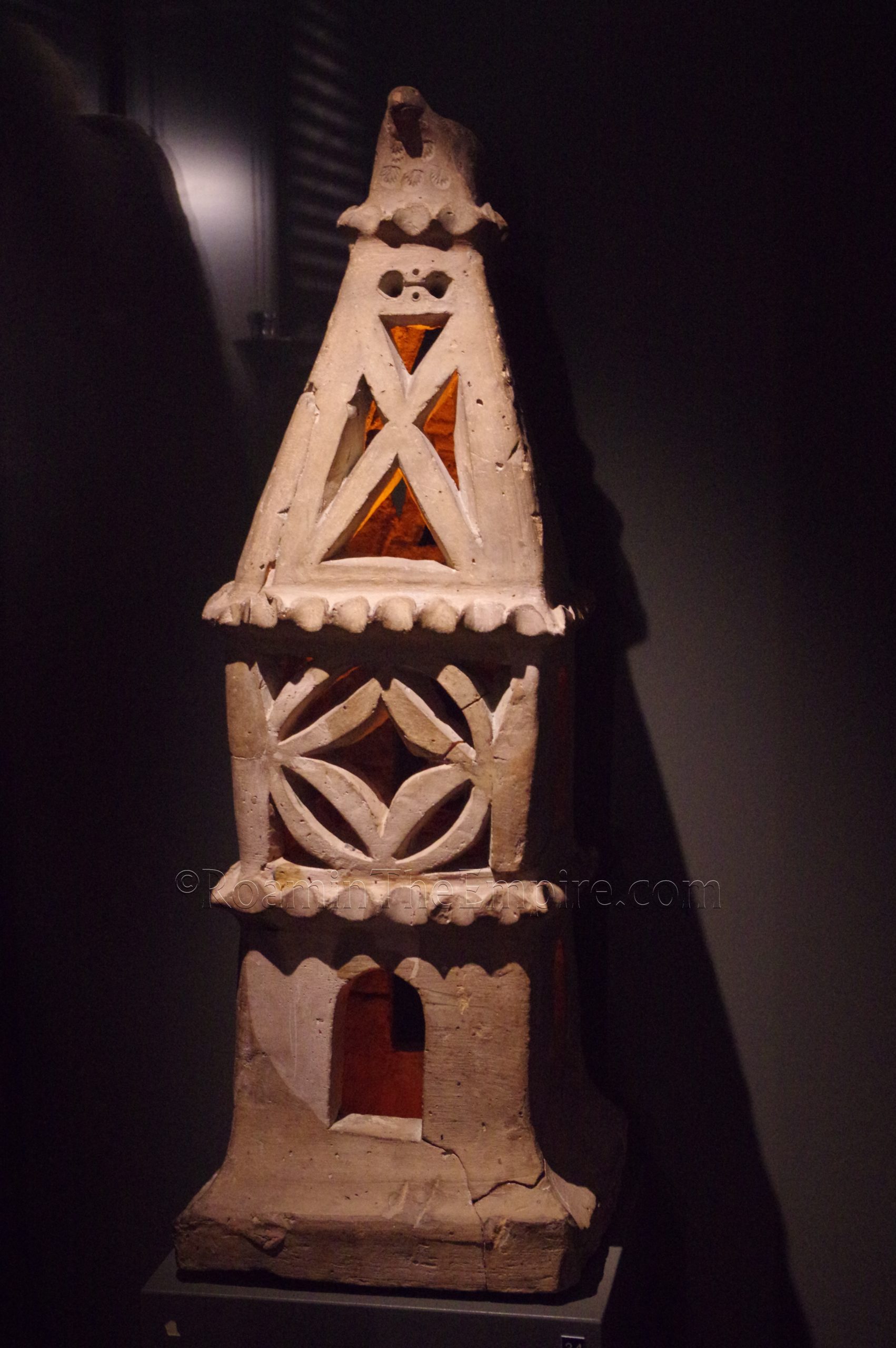
I spent a total of about 4 and a half hours at the Magyar Nemzeti Múzeum, a good 2 hours of that in the lapidary collection alone, and some of that total on the other parts of the museum I sort of strolled through. It’s a pretty well rounded collection and really does have some amazing highlights. The Sueso Treasure, which has a fascinating history, may be among the finest objects of Roman silver craftsmanship extant. There are both Hungarian and English descriptions for most, if not all the objects in the parts of the museum I mentioned (some of the newer object collections is a different story). It’s also worth noting that a relatively reasonable companion book to the Roman lapidary collection is available in the museum shop for just 2,900 Forint. While there is, again, pretty good information in the museum, the book expands a lot and contextualizes the pieces quite well.

The final spot in Budapest is located a bit out of the city center, in Városliget (City Park), but which is connected with the center by metro (Hősök tere stop). At Dózsa György út 41 is the Szépművészeti Múzeum, the Fine Arts Museum. The façade of the building itself has a replica of the west pediment of the Temple of Zeus at Olympia. The museum is open Tuesday through Sunday from 10:00 to 18:00 and is closed on Monday. Base admission to the museum (which may vary with some exhibitions) is 4,800 Forint. When I visited, the line to buy tickets was quite long, right at opening. The ticket holders line moved much, much more quickly, so it might be advisable to buy a ticket online to save some time (I didn’t get in until a half an hour after opening).
This museum has a pretty varied collection of antiquities. Unlike the Hungarian National Museum, which featured only objects originating in Hungary (the disputed provenance of the Sueso Treasure notwithstanding) while the Fine Arts Museum’s archaeological collections include objects from beyond the borders, which includes quite a nice collection of Greek and Egyptian objects. All these collections are contained in several rooms in the basement level of the museum. The main hall has sort of a temporal overview, with the visitor path starting with the oldest objects (Cycladic figure) and progressing toward the Roman period. The flanking halls are more of a mix of Greek and Roman with a more thematic grouping in those rooms, rather than temporal. The Egyptian collection is in a separate wing.
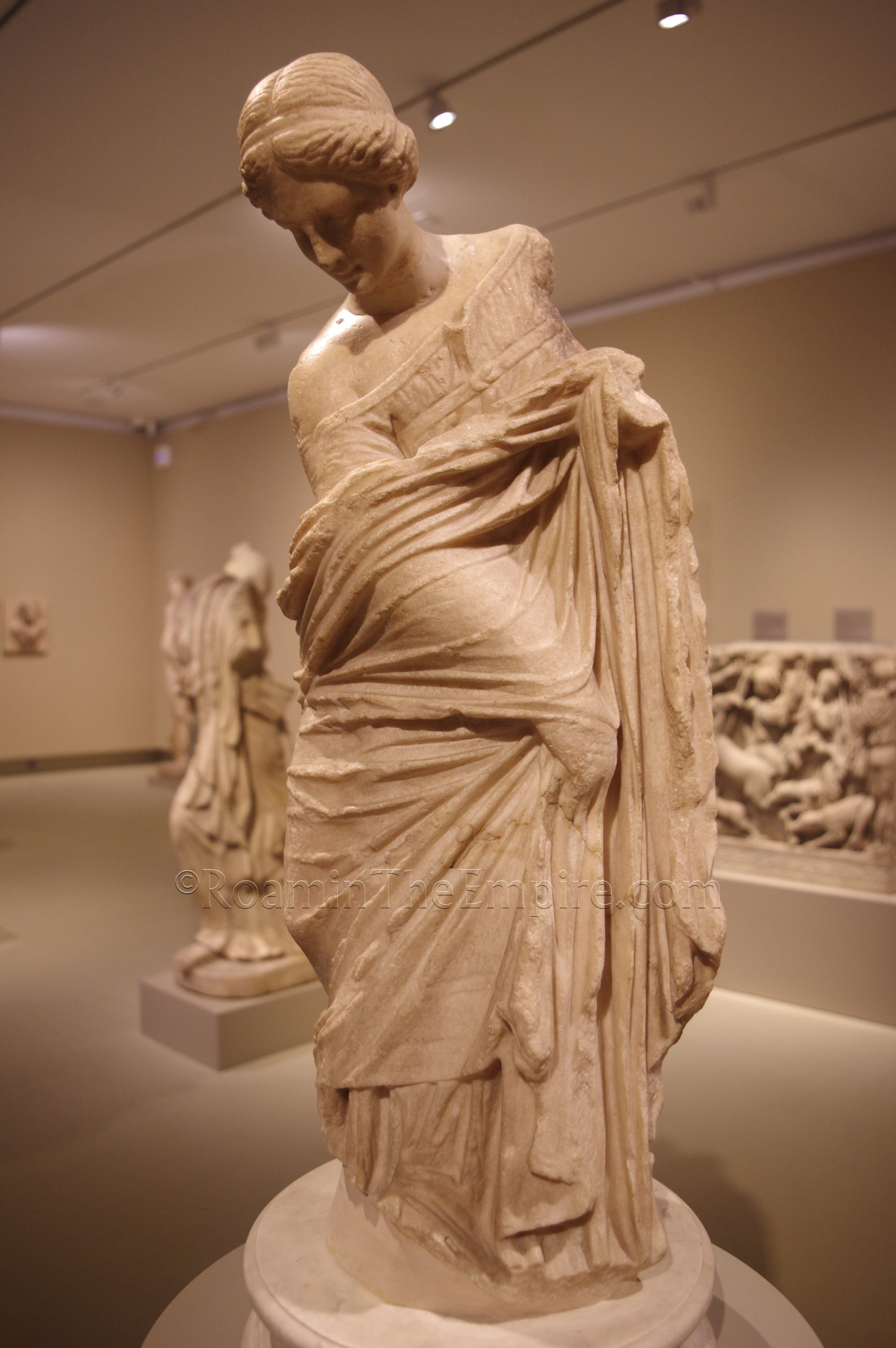
Some highlights from the collection of the Fine Arts Museum are a number of Roman reliefs that include three fragments from the Medinaceli reliefs commemorating Augustus victory at the Battle of Actium. One of these is a nice panel depicting a triumphal procession. The museum has a number of Fayum mummy portraits and a small mosaic depicting Orpheus among the animals. There’s a good collection of smaller bronze objects as well as some larger statuary including the so-called Budapest Dancer, a statue of a young girl from Rome dating to the 3rd or 2nd century BCE.

I spent a little more than 4 hours in the ancient collections and then another 2 hours going through the rest of the collections, which included quite a few later works with classical myth representation or themes (as 16th to 19th century art tends to). It’s a very good museum, there was obviously a lot to see, though it was a much more varied collection than the National Museum, which seemed primarily more focused on the flashier objects. This museum definitely painted a better picture of some aspects of the ancient world; though the two in combination make for a phenomenal collection of ancient archaeological objects for Budapest. If you only had time for one of the museums, though, I would reluctantly recommend the National Museum, just because the highlights are pretty high.
All told, the Roman archaeological areas and museums made for a pretty packed 3 days. I comfortably fit everything in to those 3 days, but it certainly was not a leisurely pace, particularly the day I saw most of the archaeological sites.
Sources:
Ammianus Marcellinus. Res Gestae, 30.5.
Grant, Michael. A Guide to the Ancient World: A Dictionary of Classical Place Names. New York: Barnes & Noble Books, 1997.
Kiss, Zsuzsanna Emília. “The Inscriptions of the Construction and Recovery Works of the Public Buildings and Utilities in Aquincum.” Periodica Polytechnica Architecture, Vol 51, No. 2 (2020), pp. 108-123.
Láng, Orsolya. “Functions and Phases: The ‘Peristyle-House’ in the Civil Town of Aquincum.” DOMUS: Das Haus in den Städten der römischen Donauprovinzen, Peter Scherrer, Österreichisches Archäologisches Institut Wien, 2008, pp. 271-284.
Láng, Orsolya. “Industry and Commerce in the City of Aquincum.” Urban Craftsmen and Traders in the Roman World, Andrew Wilson and Miko Flohr, Oxford University Press, 2016, pp. 352-376.
Láng, Orsolya. “Reconsidering the Aquincum Macellum.” Acta Archaeologica Academiae Scientarium Hungaricae. Vol. 54 (2003), pp. 165-204.
Nagy, Mihály. Roman Stones: A Guide to the Archaeological Exhibitions in the Hungarian National Museum. Budapest: Hungarian National Museum, 2012.
Smith, William. Dictionary of Greek and Roman Geography. Walton & Murray, 1870.
Stillwell, Richard, William L. MacDonald, and Marian Holland. McAllister. The Princeton Encyclopedia of Classical Sites. Princeton, NJ: Princeton U Press, 1976.
Szabó, Csaba. Sanctuaries in Roman Dacia: Materiality and Religious Experince. Oxford: Archeopress, 2018.



Once again, I’m thoroughly jealous of your travels. And there’s one of the Medinaceli reliefs – a gold standard of its kind. Wish I could have seen all of them when new and freshly painted. Thanks for sharing!
Yes, it was such a treat to get to see that! What it would have been to have seen that whole monument in its heyday, it must have been spectacular. And as always, appreciate your comments and glad to know you’re enjoying the posts!